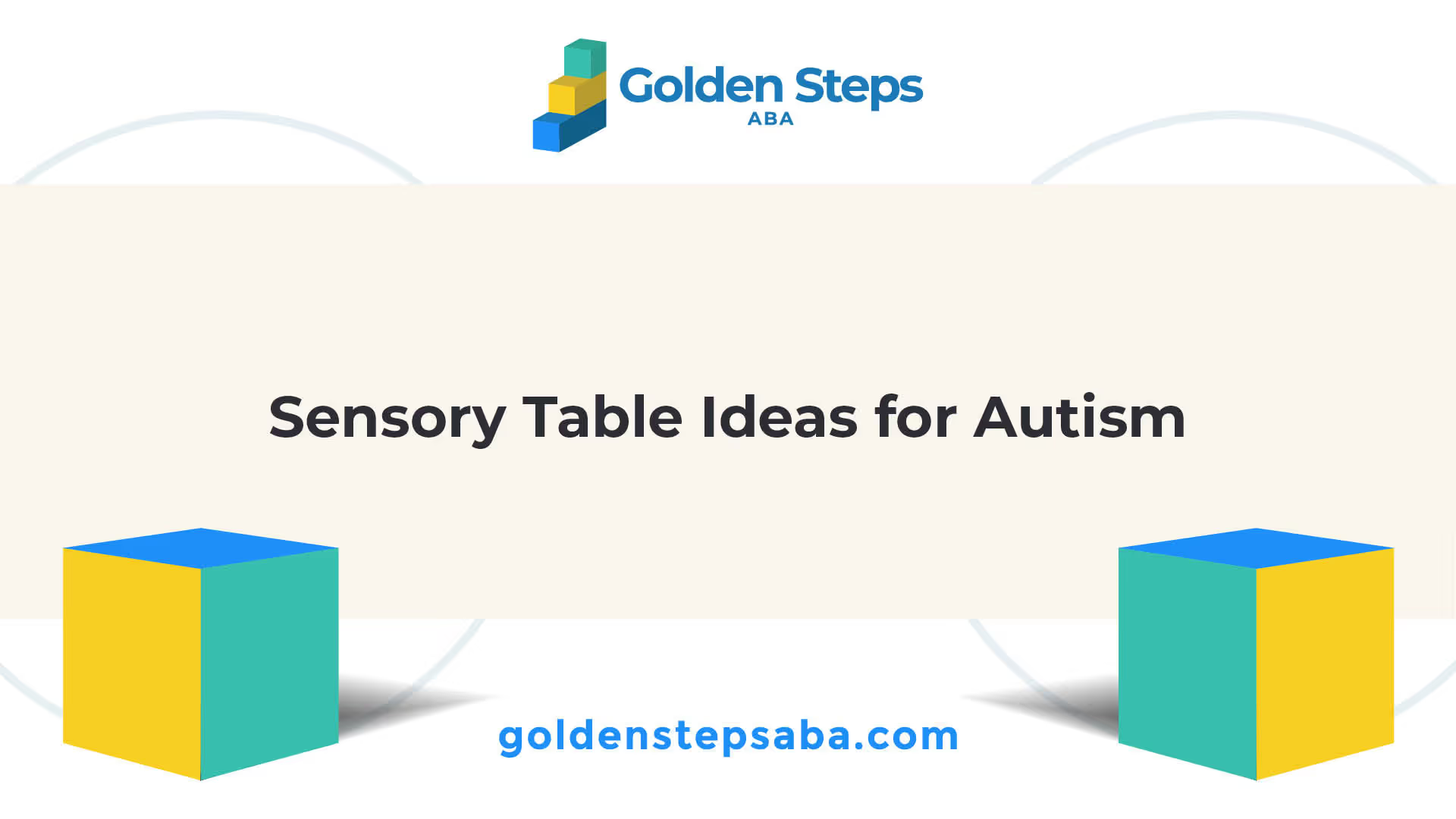Importance of Sensory Tables
Sensory tables play a crucial role in the development and well-being of individuals with autism. These tables provide a structured environment for engaging in sensory activities, which can help regulate sensory input and improve overall quality of life.
Sensory Activities for Autism
Individuals with autism often exhibit heightened sensitivity to sensory stimuli, which can lead to difficulties in processing and responding to sensory information. Sensory activities provide a safe and controlled environment for these individuals to explore and interact with different sensory stimuli. These activities can include deep pressure, tactile, and visual stimulation activities, all of which can be particularly calming for individuals with autism [1].

Research has shown that engaging in sensory activities can be highly effective in alleviating anxiety and promoting positive behavior in individuals with autism. For instance, a study conducted in 2001 demonstrated a significant improvement in on-task behavior for students wearing weighted vests, a form of deep pressure activity. Moreover, another study in 2008 found that 63% of participants with autism experienced lower anxiety levels after using weighted blankets as a calming strategy, with 78% of participants preferring the blanket as a calming tool [1].
Benefits of Sensory Tables
Incorporating a sensory table into the classroom or home environment has numerous benefits for individuals with autism. Sensory tables stocked with different materials like sand, water, or rice can stimulate tactile exploration, enhance fine motor abilities, and encourage imaginative play.
Ultimately, sensory tables provide a versatile and effective tool for facilitating sensory activities. With the right materials and guidance, these tables can transform into a sensory wonderland, offering countless sensory table ideas for autism and serving as a valuable resource for parents and educators alike.
Types of Sensory Activities
Incorporating sensory activities into the daily routine of individuals with autism can be highly beneficial. These activities can help regulate sensory input, reduce anxiety, and promote positive behavior, leading to an improvement in overall well-being and quality of life. Sensory activities can be categorized into different types, including deep pressure, tactile, and visual stimulation activities.
Deep Pressure Activities
Deep pressure activities apply firm but gentle pressure to the body, providing a calming effect. One popular example is the use of weighted vests or blankets. According to a study in 2001, students wearing weighted vests demonstrated remarkable improvement in on-task behavior. Another study in 2008 found that 63% of participants with autism experienced lower anxiety levels after using weighted blankets as a calming strategy, with 78% preferring the blanket as a calming tool.
Tactile Stimulation Activities
Tactile stimulation activities involve physical contact with various textures and materials, fostering tactile stimulation and enhancing fine motor abilities. A sensory table stocked with materials like sand, water, or rice can be a great tool for tactile stimulation. This allows individuals with autism to discover and experiment with different textures in a controlled and safe environment [1].
Visual Stimulation Activities
Visual stimulation activities involve the use of objects and materials that are visually appealing. These activities can help individuals with autism focus their attention, reduce anxiety, and promote relaxation. Examples of visual stimulation activities may include watching spinning objects, light-up toys, and color-changing LED lights.
By incorporating these sensory activities into their routine, individuals with autism can enhance their sensory processing skills, leading to overall improvements in their quality of life. These sensory table ideas for autism can be a great starting point for creating a sensory-friendly and enriching environment.
Incorporating Sensory Tables
The incorporation of sensory tables into the learning environment can be a significant step toward fostering the development of children with autism. These tables can stimulate multiple senses, promote fine motor skills, and enhance language skills, making them ideal tools for sensory play.
Creating a Sensory Table Environment
In creating a sensory table environment, it's important to consider the different types of sensory activities that are beneficial for individuals with autism. These can include deep pressure, tactile, and visual stimulation activities, all of which can be particularly calming.
The sensory table should be a safe and comfortable space where children can explore and experiment at their own pace. It should be easily accessible and placed in a quiet area of the room to minimize distractions. To encourage interaction and communication, consider setting up two or more tables where children can play together.
Ensure that the sensory table environment is adaptable and can be adjusted based on the child's needs and responses to different stimuli. For instance, if a child finds a certain texture or material uncomfortable, it can be removed or replaced with something more suitable.
Materials for Sensory Tables
The materials used in sensory tables can vary greatly, but the goal should be to provide a range of textures and sensations that promote tactile stimulation and enhance fine motor abilities. Materials such as sand, water, or rice can enable children with autism to discover, experiment, and engage in sensory play.
Other materials that can be used in sensory tables include:
- Play dough or clay: These can be squeezed, rolled, and shaped, promoting fine motor skills.
- Fabric scraps: Different textures and patterns can stimulate the sense of touch.
- Beads or buttons: These can be sorted by size, color, or shape, promoting cognitive development.
- Sensory gel pads: These can provide a soothing and calming effect through tactile stimulation.
The manipulation of these different textures and materials provides various opportunities for children to practice and enhance their fine motor skills, such as eye-hand coordination and finger strength [2].
Incorporating sensory tables in the classroom environment can provide children with autism the opportunity to engage in sensory play, which can enhance their sensory processing skills, promote cognitive development, and improve social interaction. When selecting materials for sensory tables, consider the child's individual needs, preferences, and sensory sensitivities to create an effective and engaging sensory learning environment.
Evidence-Based Practices for Autism
In the realm of autism education, it's important to put into practice strategies that are backed by reliable research and proven to be effective. The U.S. federal government has set forth mandates to ensure the utilization of such practices, and several evidence-based practices (EBP) have been identified for improving outcomes for students with autism.
Federal Mandates for Autism Education
Two federal laws, the Every Student Succeeds Act (ESSA) and the Individuals with Disabilities Education Act (IDEA '04), mandate that educators use evidence-based academic and behavioral practices and programs for children with autism. These laws ensure that the strategies used in educating individuals with autism are well-researched and have a track record of success. They also ensure that every student with autism has access to the quality education they deserve.
Evidence-Based Practices for Autism
The National Professional Development Center (NPDC) on Autism Spectrum Disorder has identified 27 evidence-based practices for improving outcomes for students with autism.
When selecting an EBP for a child or student with autism, educators and practitioners should consider the student's characteristics, staff expertise, and available resources. The target behavior needs to be determined, baseline data collected, and the goal indicated in the child's individualized education program (IEP) or individualized family service plan (IFSP).
It is crucial to collect data on the behavior and evaluate the effectiveness of the EBP for the individual student. Fidelity of implementation should also be assessed. This ensures that the strategy is being carried out as intended and helps determine whether adjustments need to be made to better suit the needs of the student [4].
In summary, evidence-based practices are a cornerstone of quality autism education. It is not only important to select appropriate strategies but also to track their effectiveness and adjust as needed. By doing so, parents, educators, and practitioners can help individuals with autism achieve their full potential.
Sensory Rooms for Autism
Sensory rooms are specialized environments designed to provide individuals with a safe and supportive space to explore and engage with a variety of sensory stimuli. These rooms are particularly beneficial for individuals with sensory processing impairments, such as autism.
Benefits of Sensory Rooms
Sensory rooms aid in the development of social skills and create a secure, calm, and welcoming environment that encourages interaction and turn-taking through cause-and-effect toys and games. They have gained significant popularity for their positive impact on individuals with autism, allowing them to decompress and regulate their sensory experiences in a controlled manner.
When considering sensory table ideas for autism, it's important to note the role they play in these rooms. Sensory tables stimulate multiple senses, promoting fine motor development and enhancing language skills [2]. They provide opportunities for enhancing skills such as eye-hand coordination and finger strength, crucial for the overall development of children with autism [2].
Designing Effective Sensory Environments
Designing an effective sensory room for a child with autism requires careful consideration of the child's specific sensory needs. Here are a few guidelines to consider when creating such a space:
- Variety: Include a variety of sensory stimuli to engage different senses. This could include tactile items for touch, visually stimulating objects, and auditory stimuli.
- Safety: Ensure the room is safe, with all items securely fastened and no sharp edges.
- Comfort: Create a comfortable and calming environment with soft lighting and cozy seating options.
- Personalization: Tailor the room to suit the individual needs and preferences of the child. This could involve using their favorite colors or incorporating items related to their interests.
- Flexibility: Make the room flexible so that items can be added or removed as the child's needs change over time.
By incorporating these guidelines, a sensory room can become a beneficial space for a child with autism, providing them with an environment that supports their sensory processing needs and promotes their overall development.
Visual Supports for Autism
Visual supports play a crucial role in facilitating communication and understanding among individuals with autism. These aids can significantly enhance a sensory table experience, providing structure, routine, and an interactive element that can aid in independent learning and confidence building.
Importance of Visual Supports
Visual supports are a vital element in the education and daily life of individuals with autism. They provide a physical and consistent form of communication, unlike spoken words, which are transient. Visual supports can improve understanding, prevent frustration and anxiety, and offer opportunities for interaction with others. The consistent use of visual supports can help autistic individuals navigate their environment and routines more comfortably, promoting independence and boosting confidence.
Types of Visual Supports
There is a wide range of visual supports available, allowing for customization according to individual needs and preferences. These supports can include tactile symbols or objects of reference, photographs, short videos, miniatures of real objects, colored pictures, plain squares of colored card, line drawings, symbols, and written words. These can be actual objects or digital representations, depending on the specific requirements of the individual [7].
Visual supports can be used in various ways, such as conveying a single message, creating timetables, schedules, sequences, or choice boards, illustrating social stories or comic strip conversations, and more. For example, basic symbols can be used for expressing opinions, choice boards for decision-making, colored table cloths for different activities, emotion thermometers for self-regulation, task sequence instruction strips for task completion, and visual scripts for social situations [7].
For effective use of visual supports, they should be made portable, durable, easy to find, personalized, and consistent. It's crucial to introduce these supports gradually and use them consistently to ensure effectiveness. The use of visual supports can be a powerful addition to sensory table ideas for autism, enhancing the overall learning and sensory experience for individuals with autism.
References
[1]: https://www.integrityinc.org/7-sensory-activities-for-adults-with-autism/
[2]: https://blog.stageslearning.com/blog/the-7-benefits-of-using-sensory-bins-for-children-with-autism
[3]: https://www.autismparentingmagazine.com/sensory-tables-for-children-with-autism/
[4]: https://iris.peabody.vanderbilt.edu/module/asd2/cresource/q1/p02/
[5]: https://childrensguild.org/sensory-rooms-for-children-with-disabilities/
[6]: https://www.abtaba.com/blog/sensory-room-ideas-for-children-with-autism
[7]: https://www.autism.org.uk/advice-and-guidance/topics/communication/communication-tools/visual-supports

